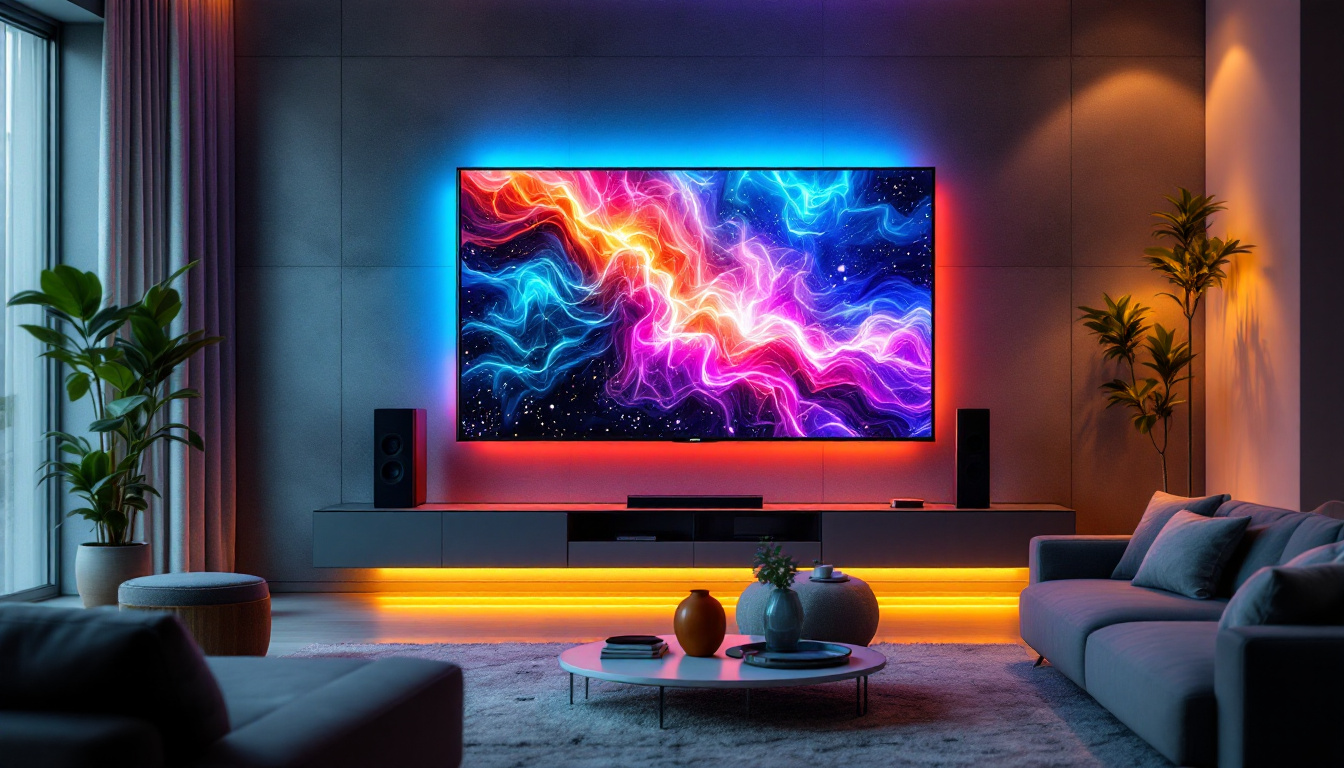Difference In LED And LCD: LED Display Explained
The world of display technology has evolved significantly over the years, leading to the emergence of various types of screens that cater to different needs and preferences. Among these, LED (Light Emitting Diode) and LCD (Liquid Crystal Display) are two of the most prominent technologies. Understanding the differences between them is essential for anyone looking to purchase a new television, monitor, or other display devices. This article delves into the characteristics, advantages, and limitations of LED and LCD displays, providing a comprehensive overview of each technology.
Understanding LCD Technology
Liquid Crystal Display (LCD) technology has been a staple in the display market for decades. It utilizes liquid crystals that modulate light to produce images. The fundamental principle behind LCDs is that liquid crystals can change their alignment when an electric current is applied, allowing them to control the passage of light. However, LCDs do not emit light by themselves; they require a backlight to illuminate the display.
How LCD Works
In an LCD screen, a layer of liquid crystals is sandwiched between two polarizing filters. When an electric current passes through the liquid crystals, they twist and allow varying amounts of light to pass through. This process creates the images that we see on the screen. The backlight, usually made up of fluorescent tubes or LEDs, provides the necessary illumination for the display.
LCDs are known for their ability to produce sharp images with excellent color reproduction. They are widely used in televisions, computer monitors, and mobile devices due to their thin profile and lightweight design. However, the quality of an LCD display can vary significantly depending on the type of backlighting used and the quality of the liquid crystals themselves. The introduction of technologies such as In-Plane Switching (IPS) and Vertical Alignment (VA) has further enhanced the viewing angles and color accuracy of LCDs, making them even more appealing for professional applications, such as graphic design and photography.
Advantages of LCD Displays
One of the primary advantages of LCD technology is its energy efficiency. Compared to older technologies like CRT (Cathode Ray Tube), LCDs consume significantly less power, making them a more environmentally friendly option. Additionally, LCD screens are less prone to screen burn-in, a problem that can affect other display types.
Another benefit is the availability of a wide range of sizes and resolutions. LCDs can be found in everything from small portable devices to large televisions, catering to various consumer needs. Furthermore, advancements in LCD technology have led to the development of high-definition (HD) and ultra-high-definition (UHD) displays, providing even more options for consumers seeking superior image quality. The evolution of LCDs has also seen the rise of features such as touch sensitivity, which has transformed how users interact with devices, allowing for more intuitive navigation and control. This integration of touch technology has made LCDs a popular choice for smartphones, tablets, and interactive kiosks, further expanding their versatility in today’s tech landscape.
Exploring LED Technology
LED technology, while often discussed in conjunction with LCDs, is a distinct display technology that employs light-emitting diodes as its primary source of illumination. While the term “LED display” is commonly used, it is important to note that most LED displays are essentially LCDs that use LEDs for backlighting instead of traditional fluorescent tubes. This distinction is crucial for understanding the differences between the two technologies.
How LED Works
LED displays utilize a matrix of tiny light-emitting diodes to create images. These diodes emit light in various colors, which can be combined to produce a full spectrum of colors. In the case of LED-backlit LCDs, the LEDs serve as the backlight for the liquid crystal layer, enhancing brightness and color accuracy.
There are two primary types of LED backlighting: edge-lit and full-array. Edge-lit LED displays have LEDs positioned along the edges of the screen, while full-array LED displays feature a grid of LEDs behind the entire screen. Full-array displays typically offer better contrast and uniformity, as they can control local dimming more effectively than edge-lit models.
Advantages of LED Displays
One of the most significant advantages of LED displays is their superior brightness and contrast compared to traditional LCDs. The use of LEDs allows for higher brightness levels, making them ideal for viewing in well-lit environments. Additionally, the ability to control local dimming in full-array LED displays enhances the contrast ratio, resulting in deeper blacks and more vibrant colors.
LED displays are also known for their longevity and durability. LEDs have a longer lifespan than traditional backlighting methods, which means that LED displays can maintain their performance over time with less risk of degradation. This longevity, combined with energy efficiency, makes LED displays a popular choice for both consumers and businesses.
Key Differences Between LED and LCD Displays
While LED and LCD displays are often discussed together, there are several key differences that set them apart. Understanding these differences can help consumers make informed decisions when purchasing a display device.
Backlighting Technology
The most significant difference between LED and LCD displays lies in their backlighting technology. Traditional LCDs use fluorescent backlighting, which can result in less vibrant colors and lower contrast ratios. In contrast, LED displays utilize light-emitting diodes, providing enhanced brightness, color accuracy, and contrast. This difference in backlighting technology is a crucial factor in determining the overall image quality of the display.
Image Quality and Performance
When it comes to image quality, LED displays generally outperform traditional LCDs. The ability to achieve higher brightness levels and better contrast ratios makes LED displays more suitable for various viewing environments, especially in bright rooms. Additionally, advancements in LED technology, such as local dimming, further enhance the image quality by allowing for better control over how light is distributed across the screen.
However, it is essential to note that not all LED displays are created equal. The quality of the display can vary based on factors such as the type of LED backlighting used and the overall build quality of the screen. Therefore, consumers should consider these factors when evaluating different display options.
Energy Efficiency
Both LED and LCD displays are more energy-efficient than older technologies like CRTs. However, LED displays tend to be more energy-efficient than traditional LCDs due to their advanced backlighting technology. The use of LEDs allows for higher brightness levels without significantly increasing power consumption, making them a more sustainable choice for consumers concerned about energy usage.
Applications of LED and LCD Displays
Both LED and LCD displays have found applications in various fields, from consumer electronics to commercial use. Understanding where each technology excels can help consumers and businesses make informed decisions about which display type to choose for their specific needs.
Consumer Electronics
In the realm of consumer electronics, LED displays have become the standard for televisions and computer monitors. Their superior image quality, energy efficiency, and sleek designs make them a popular choice for home entertainment systems. Additionally, many smartphones and tablets now utilize LED technology to deliver vibrant and sharp visuals.
On the other hand, LCD displays still hold a significant market share, particularly in budget-friendly devices. Many entry-level monitors and televisions utilize traditional LCD technology, providing satisfactory performance for consumers who do not require the latest advancements in display technology.
Commercial Use
In commercial settings, LED displays have gained popularity for advertising and signage due to their brightness and visibility. digital billboards and outdoor displays often utilize LED technology to ensure that content remains visible even in direct sunlight. Furthermore, LED displays are commonly used in conference rooms and presentation settings, where high-quality visuals are essential for effective communication.
LCDs, while less common in high-visibility applications, are still widely used in office environments for computer monitors and informational displays. Their affordability and adequate performance make them a suitable choice for many businesses.
Future of Display Technology
The landscape of display technology continues to evolve, with both LED and LCD technologies undergoing advancements to improve performance and user experience. Emerging technologies, such as OLED (Organic Light Emitting Diode) and MicroLED, are gaining traction and may eventually challenge the dominance of traditional LED and LCD displays.
Emerging Technologies
OLED technology, known for its ability to produce true blacks and vibrant colors, has gained popularity in high-end televisions and smartphones. Unlike LED and LCD displays, OLED panels do not require a backlight, as each pixel emits its own light. This results in superior contrast ratios and color accuracy, making OLED a compelling alternative for consumers seeking the best possible image quality.
MicroLED is another emerging technology that promises to deliver the benefits of both LED and OLED displays. MicroLED panels consist of tiny, self-emissive LEDs that can produce stunning visuals with high brightness and excellent color reproduction. As this technology matures, it may become a viable option for consumers and businesses alike.
Conclusion
In summary, understanding the differences between LED and LCD displays is crucial for making informed purchasing decisions. While both technologies have their advantages and limitations, LED displays generally offer superior image quality, brightness, and energy efficiency compared to traditional LCDs. As display technology continues to evolve, consumers can expect even more options and innovations in the future.
Whether one opts for an LED or an LCD display, it is essential to consider individual needs, preferences, and budget. By doing so, consumers can ensure that they choose a display that meets their requirements and enhances their viewing experience.
Discover LumenMatrix’s Innovative LED Solutions
Ready to experience the pinnacle of display technology? LumenMatrix is at the forefront of LED innovation, offering a wide array of LED display solutions that cater to your unique needs. From vibrant Indoor and Outdoor LED Wall Displays to dynamic Vehicle and Sports LED Displays, our products are designed to captivate and engage your audience. Whether you’re looking to create an immersive experience with our Floor and Custom LED Displays or seeking the sleek design of our All-in-One and Transparent LED Displays, LumenMatrix has the cutting-edge technology to bring your vision to life. Elevate your visual communication and make a lasting impression with our LED display modules. Check out LumenMatrix LED Display Solutions today and transform the way you share your message.































